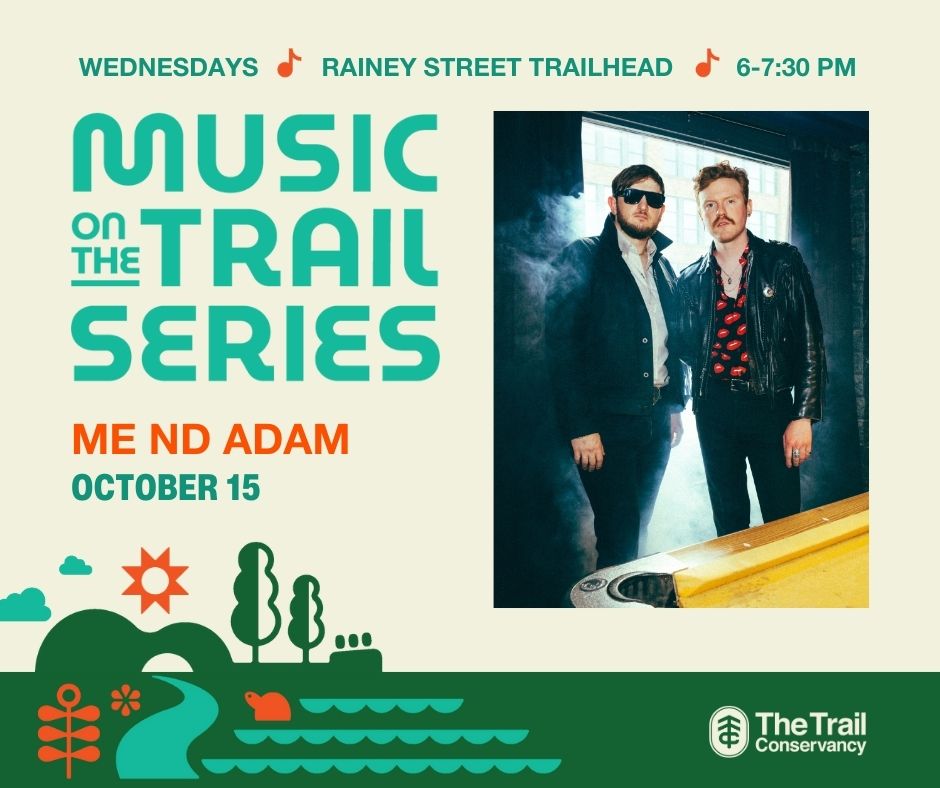
History of the Zilker Bluffs Tree Grove
Written by Griffin Davis, board member and 15th anniversary co-chair of The Trail Foundation.
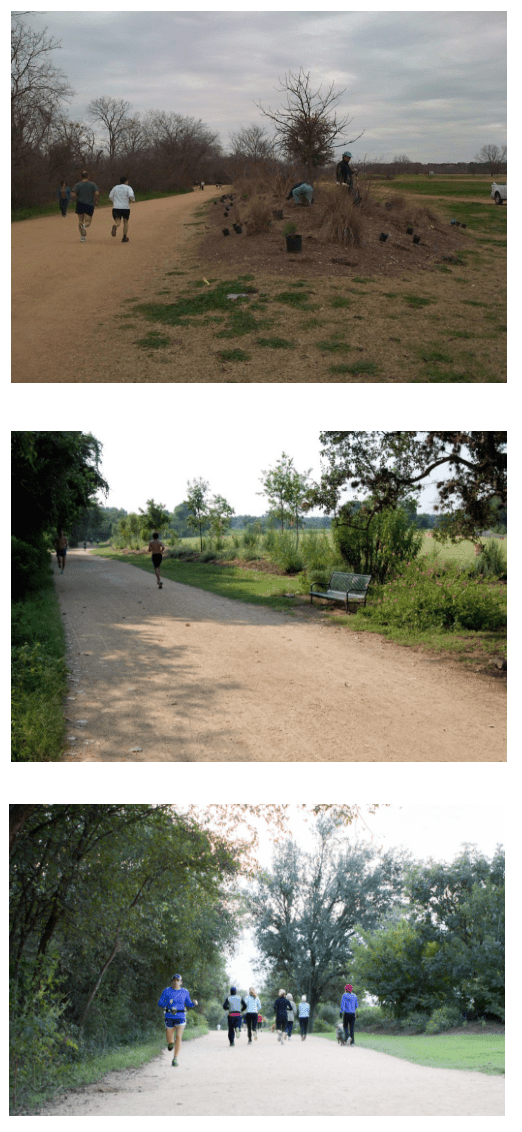
In 2006, the Town Lake Trail Foundation (TTF’s original name prior to 2009) was a young and active group. Our primary focus was making capital improvements to the Butler Trail’s infrastructure. Built predominantly in the 1970s and 1980s, the Trail was aging poorly. Retaining walls at Lou Neff Point were collapsing, the design of the stretching and gathering area underneath Mopac was not safe or visually appealing to the crowds of folks who gathered there, and although usage had skyrocketed, no new restroom had been added anywhere along the Trail in more than 20 years.
But it had been even longer since any major effort had been made to improve the Trail’s green spaces. The Trail had come to life in the 1970s thanks in large part to the Citizens’ Committee for a More Beautiful Town Lake. The Citizens’ Committee’s mission, in part, was to prepare Town Lake for America’s Bicentennial celebration. Led by Honorary Chairwoman Lady Bird Johnson, the Committee planted hundreds of trees, installed gardens and vegetation, and worked with the City to protect what remained of the tree canopy along the Trail. Their work was substantially complete by 1976.
From its inception in 2003, The Trail Foundation recognized the Trail’s green spaces as one of its most important assets. Two of the Foundation’s earliest projects, the Lady Bird Johnson Adopt-a-Garden program and Healthy Trees for the Trail (HTFT), reflect that focus on improving the Trail’s natural areas.
In fall 2006, as part of HTFT, The Trail Foundation completed a major tree planting effort on one of the most heavily used sections of the Trail known as Zilker Bluffs– the area on the south side of the lake and just east of the Mopac Bridge and the Roberta Crenshaw Pedestrian Bridge. The parkland between the Trail and the lake’s edge had many trees along the steep slope. But, save for one mature live oak, there were no trees in the area between the Trail and Stratford Drive. No trees meant no shade. Exposed to the full afternoon sun, it was one of the hottest spots on the Trail. The heat and complete lack of tree canopy made it a place many Trail users sought to simply get through. The Trail Foundation decided this was an area that could easily be improved.
TTF had established the Healthy Trees for the Trail program in 2004, which aimed to increase the size and health of the tree canopy around the Trail. Under that program, the Foundation had already planted native trees at dozens of locations along the Trail. We thought tree planting along the Zilker Bluffs would be fairly straightforward. We were wrong.
When we told the Austin Parks and Recreation Department (PARD) about our desire to add some shade trees to create a better border between the Trail and the open field along Stratford Drive, they said they needed to check with the COA’s Solid Waste Services first. When we asked why, we learned that what we thought was just an open field was actually the top cover of a former municipal dump known as the Butler Landfill.
The Butler Landfill operated from the 1940s until 1968 and predates the construction of Mopac in the 1970s as well as the formation of Lady Bird Lake in 1960. It is surprising to many that a landfill operated in the middle of Austin. But the location of old landfills provides an instructive window into the past. Back in the 1940s, the Butler Landfill was at the edge of town. The residential neighborhood further down the road on Stratford Drive had yet to be built. A landfill at today’s Zilker Park may seem less astounding when you consider another example from a dump-centric look at Austin’s history. A 1984 COA-commissioned study of landfills revealed that Austin’s oldest known officially sanctioned dump site operated from 1927 to 1929 in the 1200 block of South Congress.
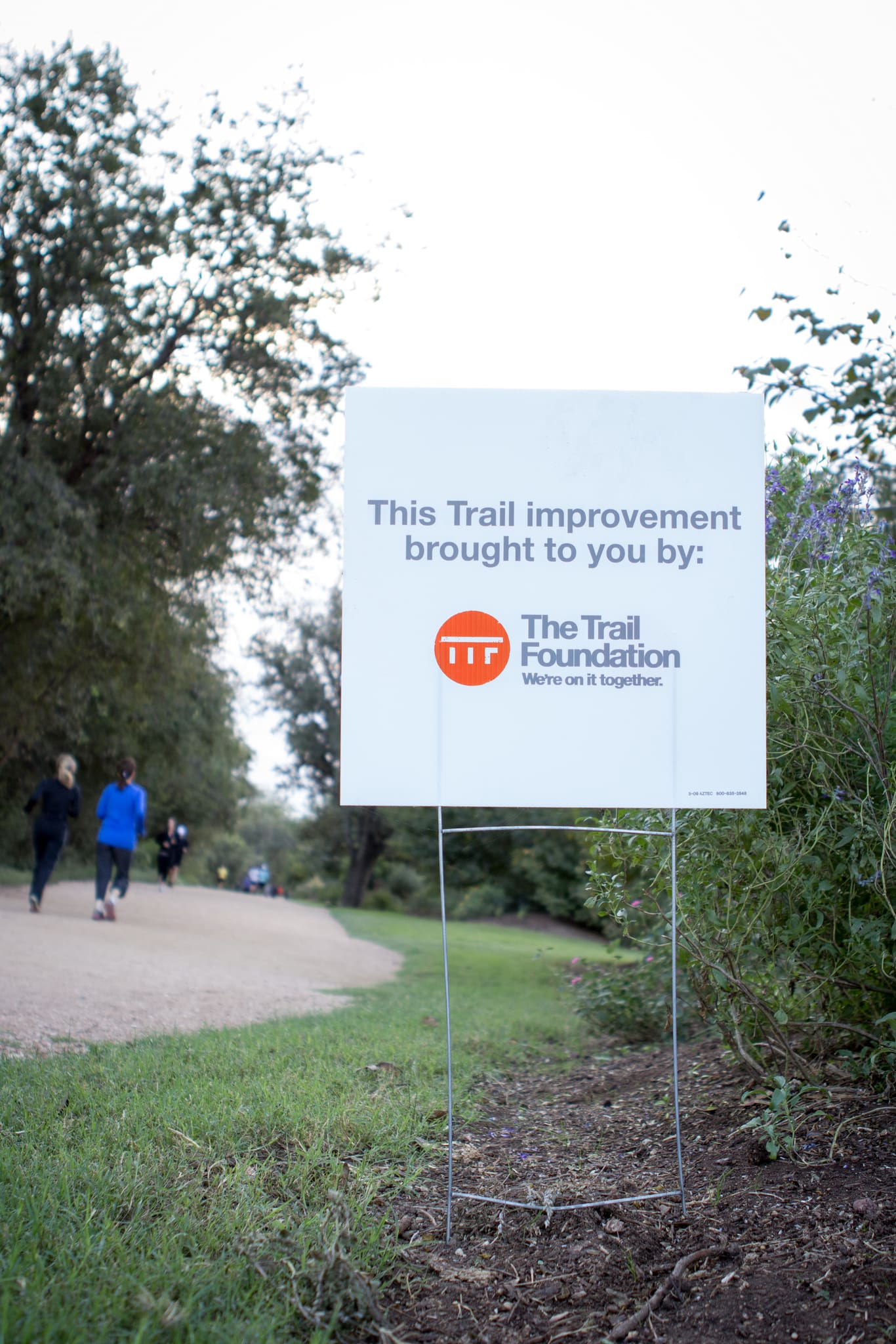 Solid Waste Services was initially reluctant to okay any major planting, especially of trees, for fear that the clay cover used to close the landfill over 50 years ago would be pierced with roots. Cracking the clay could be like opening Pandora’s Box, creating an escape hatch for whatever dangers might be hiding in the old pit. There is legitimate reason for concern. Although this dump took primarily residential waste and was not likely to be the site for toxic waste disposal (source: 1984 URM COA Landfills Report), that likely is not a certainty. Further, the dump site is far from ideal. It is perched on top of the Edwards Formation and the soil beneath the site is porous and gravelly. The bottom of the landfill appears to be below the water level of the lake. These conditions increase the chance that water could percolate from above and leach into an active part of the water table. Further, erosion, since remediated, previously occurred in area along Eanes Creek which is west of Mopac at the edge of Butler Landfill site. This erosion was noted in 2004 in a Supplemental Landfill Assessment commissioned by the City of Austin. That assessment noted that “None of our findings indicate an obvious and imminent threat to public safety” and further, in regards to the Butler Landfill only suggested the following actions:
Solid Waste Services was initially reluctant to okay any major planting, especially of trees, for fear that the clay cover used to close the landfill over 50 years ago would be pierced with roots. Cracking the clay could be like opening Pandora’s Box, creating an escape hatch for whatever dangers might be hiding in the old pit. There is legitimate reason for concern. Although this dump took primarily residential waste and was not likely to be the site for toxic waste disposal (source: 1984 URM COA Landfills Report), that likely is not a certainty. Further, the dump site is far from ideal. It is perched on top of the Edwards Formation and the soil beneath the site is porous and gravelly. The bottom of the landfill appears to be below the water level of the lake. These conditions increase the chance that water could percolate from above and leach into an active part of the water table. Further, erosion, since remediated, previously occurred in area along Eanes Creek which is west of Mopac at the edge of Butler Landfill site. This erosion was noted in 2004 in a Supplemental Landfill Assessment commissioned by the City of Austin. That assessment noted that “None of our findings indicate an obvious and imminent threat to public safety” and further, in regards to the Butler Landfill only suggested the following actions:
- Conduct Periodic Site Inspections.
- Continue Groundwater Monitoring,
- Corrective Action to Creek Embankments to Prevent Erosion and Exposure of Landfill Materials
This Assessment did not note any major concerns related to the integrity of the top clay cap. Nor were there prohibitions against establishing vegetation or introducing trees at the site. Sara Moore, who was a Foundation board member, master gardener and the project’s director, researched the issue to determine if plantings could be done in a way that would address SWS’s concerns.
Sara found multiple instances of successful installations of vegetative cover on top of clay-covered landfills. That vegetative cover included grasses, shrubs, wildflowers, and trees. The case history Sara’s research unearthed supported the idea that TTF could safely add trees on top of the old landfill site if we made appropriate plant selections and designed the project with an eye towards minimizing the risk of disturbing the clay cap.
Sara worked with landscape architect Curt Arnette, owner of Sitio Design Group, to develop a plan that was right for Zilker Bluffs and beneficial to the Trail. Curt is a long-time Austin resident and spent a good part of his childhood with Town Lake as his backyard when he and has parents lived at UT’s graduate housing apartment complex on Lake Austin Boulevard. Curt was very familiar with the Zilker Bluffs location and understood how adding shade trees could significantly improve the Trail user experience.
After several site visits, Curt and Sara agreed on a design that addressed safety concerns by incorporating six raised earthen berms stretched along the Trail’s edge and serving as the project’s planting areas. These berms added several feet of quality soil to the site that buffered the clay cap while providing a healthy environment for establishing new vegetation. Pitts Construction generously agreed to donate the soil.
“Plant shade trees” was the project’s bare bones concept when TTF first conceived it. The final design (see design below) called for many shade trees such as Bur Oak, Cedar Elm, Chinquapin Oak, Lacey Oak, Live Oak, and Mexican White Oak; however, Curt refined our original concept by adding grasses, understory plants like rock rose and hummingbird bush, and ornamental trees including Mexican Buckeye, Possumhaw Holly, Rusty Blackhaw Viburnum, and Texas Mountain Laurel throughout the berms. Diversifying the plant mix would help support a broader array of birds and other wildlife and create more visual appeal for Trail users.
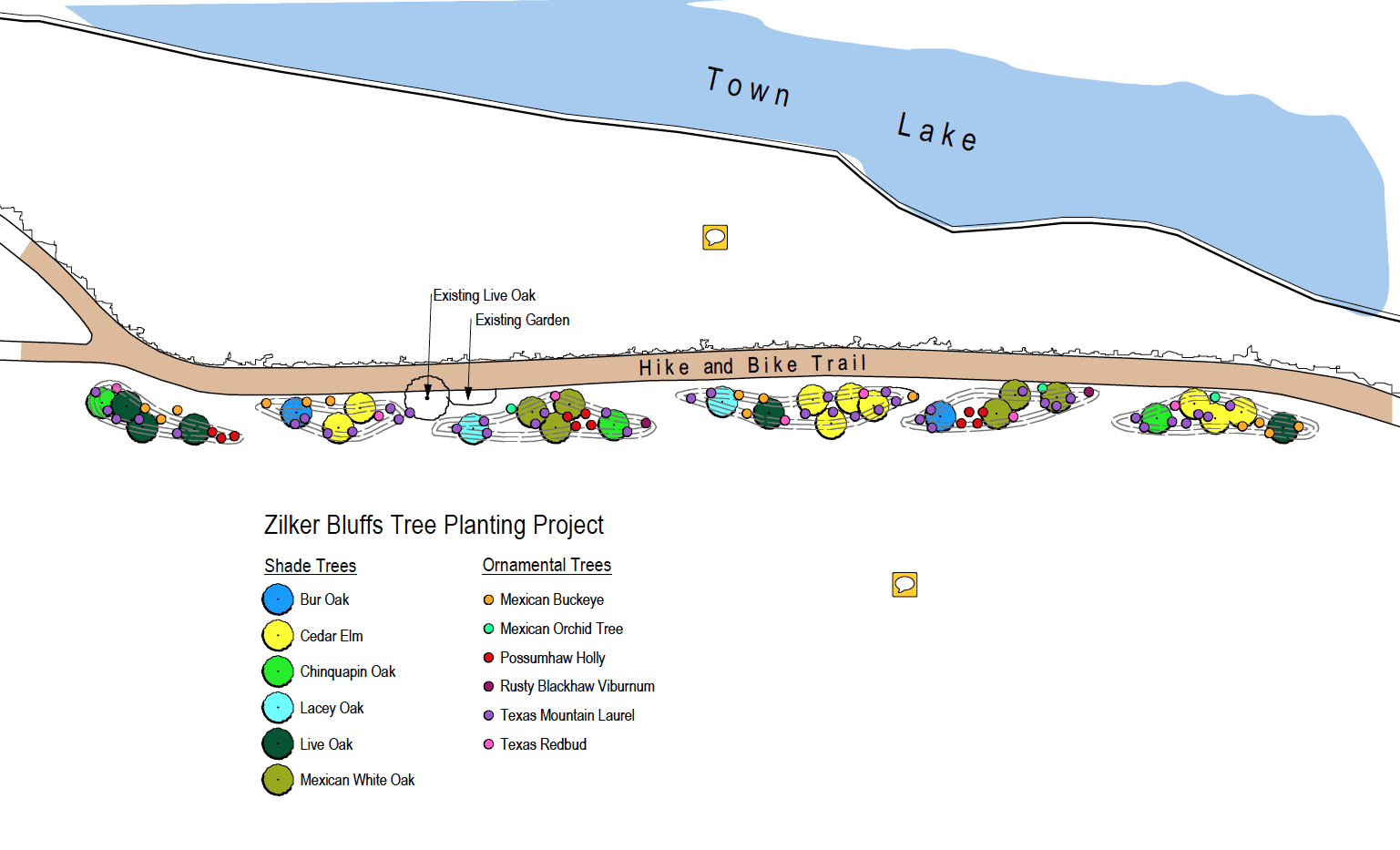
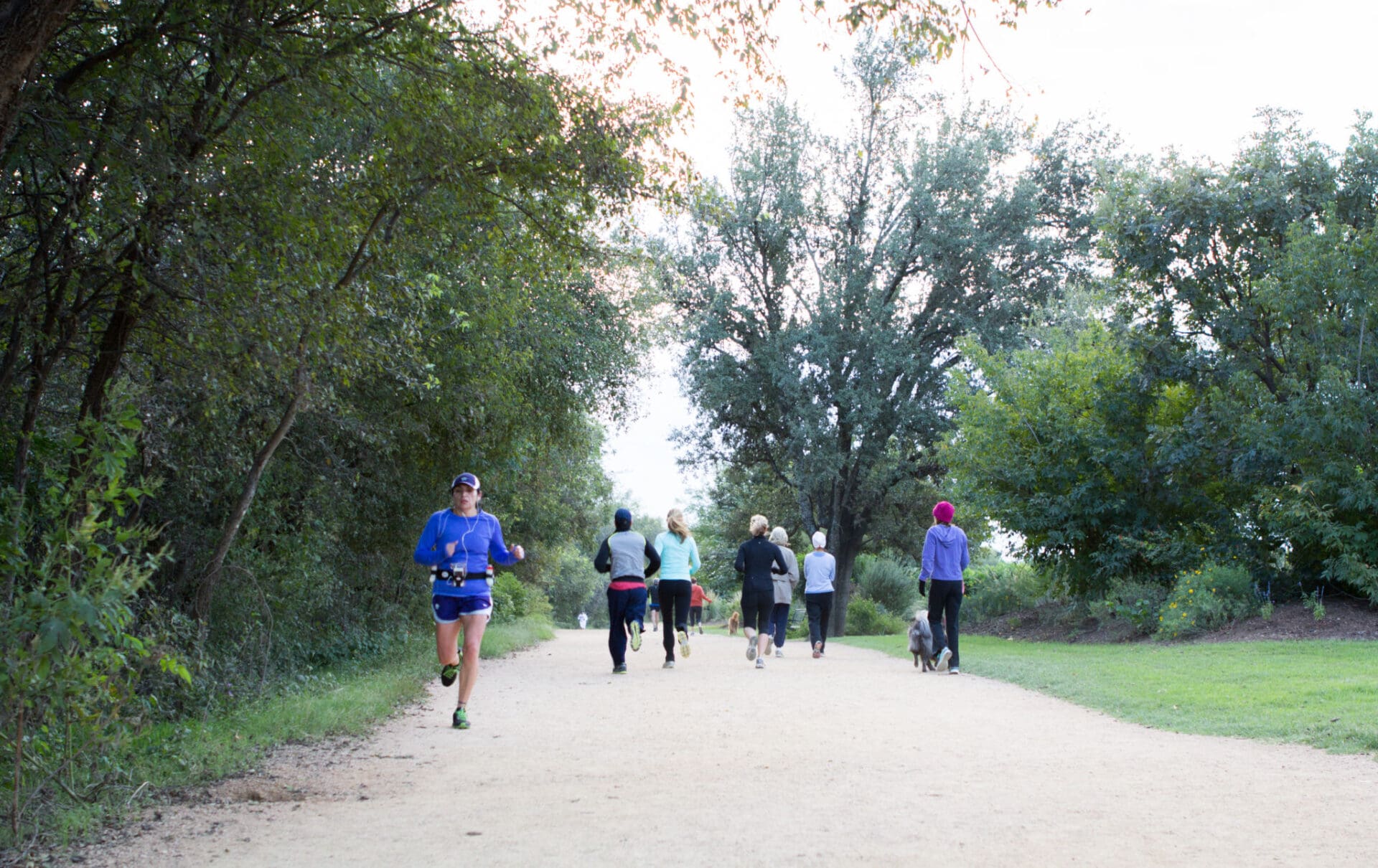 Then as now, improving plant diversity and aesthetics are winning attributes for any project by The Trail Foundation. But the folks at Solid Waste Services were ultimately swayed to okay our Zilker Bluffs Tree Grove plan because they believed the berms would provide sufficient protection for the Butler Landfill. With their approval in hand, TTF started construction of the berms in 2006. We planted 104 trees around year’s end and fortunately received sufficient rain to help establish them. Madrone Nursery of San Marcos grew grasses and wildflowers especially for Zilker Bluffs, and hundreds of these understory plants were added in 2007.
Then as now, improving plant diversity and aesthetics are winning attributes for any project by The Trail Foundation. But the folks at Solid Waste Services were ultimately swayed to okay our Zilker Bluffs Tree Grove plan because they believed the berms would provide sufficient protection for the Butler Landfill. With their approval in hand, TTF started construction of the berms in 2006. We planted 104 trees around year’s end and fortunately received sufficient rain to help establish them. Madrone Nursery of San Marcos grew grasses and wildflowers especially for Zilker Bluffs, and hundreds of these understory plants were added in 2007.
Twelve years later, the Tree Grove is now well established. Six berms are full of healthy trees, tall enough to create a shaded corridor in the afternoon. There have been no known safety issues resulting from plants damaging the clay cap of the Butler Landfill. Perhaps the raised berms have served their purpose. In any event, we learned several things from this project. First, if TTF is willing to do its homework by bringing solutions to the table, we can be a better partner to the City of Austin and get more done to improve the Trail. Second, the Butler Landfill/ now-Zilker Bluffs site can support more vegetative cover if the site is properly prepped. Although the field off Stratford Drive is barren now, you only have to look to the Trail’s edge and the Zilker Bluffs Tree Grove to see a vibrant example of how the site could look.
Thanks to former board member Sara Moore for leading the project, to Curt Arnette and Pitts Construction for donating time and materials, and to all the project’s donors including major contributors Texas Realty Capital and the Michael and Susan Dell Foundation.
Sign Up for Our Newsletter:
Upcoming Events


Week of Events
Music On The Trail | Me Nd Adam
Music On The Trail | Me Nd Adam
Shake up your Wednesday nights with Music on the Trail—a free live music series right on the Ann and Roy Butler Hike and Bike Trail. Every week in October, the Rainey Street Trailhead lawn transforms into Austin’s coolest outdoor concert spot, featuring incredible local musicians.
Kids on Bikes in Parks
Kids on Bikes in Parks
Kids on Bikes in Parks is a free cycling event presented by Violet Crown, The LeadOut Foundation, and The Trail Conservancy. We have a closed course of 1000 ft of grassy parkland for children ages 5-15 to ride their bikes on. We will have open track time with experienced cyclists present to teach lessons and at the top of every hour, we will have timed laps for kids to test themselves and track their progress.
Location: 1920 E Riverside Drive, Suite A-120 PMB 223 Austin, TX 78741
Phone: 1-855-44-TRAIL
Newsletter
The Trail Conservancy is a non-profit, tax-exempt charitable organization under Section 501(c)(3) of the Internal Revenue Code. Tax ID: 87-0699956.
